Culture
The flourishing culture of Corfu and in particular the music, the theatre, the literature and the architecture depend on the historical past of the island.
The absence of Turkish domination and the influence of the Byzantine and Venetian civilization are the reasons why in Corfu there arose a culture that was very attached to its traditions but also open to the customs of other western cultures.
In the past Corfu was a center of cultural rebirth where painters, poets and artists gathered creating cultural associations like the Reading Society and then the Ionian Academy. Among these there were Dionisios Solomos, Polilas and Markoras. Also a school of modern music was founded by the composer Mantzaros and was created the first musical band.
Below we describe separately some cultural aspects of Corfu like the literature, the art, the music, the theatre and the architecture.
Literature
When Dionisios Solomos arrived on Corfu island in 1828 laid the foundation for a new intellectual society with the intent to promote the modern Greek literature.So a Ionian School was created and it was extended in all the Ionian.
Even if the Venetian did not promote the intellectual growth, many Corfiots decided to study in Italy and then to come back in order to encourage the culture. Among the debates of the intellectuals circles the most important was to decide which language had to be the official language of the literature between the Demotiki (spoken language) and the Katharevousa (language based on the ancient Greek).
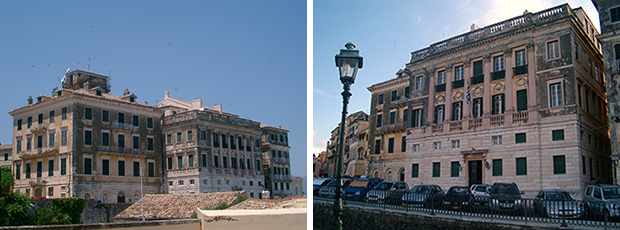
Solomos and the majority of the writers preferred the Demotiki and they wrote their works only in that language.
Among the intellectuals who influenced the literature in Corfu there are:
- Sophianos, known for his translations of many texts from the ancient Greek
- the historian Marmoras (1618-1684), the first who wrote the history of Corfu
- the historians Moustoxydis and Romanos
- the philosopher and mathematician Voulgaris (1716-1806)
- the theologian, writer and mathematician Theotokis (1731-1800), the first who brought in Greece the study of natural sciences. He also translated many works of Shakespeare.
- the poet Pieris (1776-1852)
- the literary man Delviniotis (1770-1850), became famous for his translation in Italian of the Odyssey
- the poet D. Solomos (1798-1857) who wrote the words of the "Hymn to the Freedom" that later became the Greek National hymn
- the philosopher Brailas-Armenis who pushed so that the modern Greek was the official language of the Ionian Government publications
- the literary critic Kalosgouros known for his translations
- the poet Mavilis who wrote numerous sonnets and translated the works of Byron, Shelley, Schiller and others
- the medical professor Zavitzianos (1810-1881), author of many books of medicine. He founded also the first private school for girls.
Today the literary tradition go on thanks to three institutions still present on the island: the Society of Studies of Corfu, the University and the Reading Society.
Art
Art in Corfu has been influenced from the different dominations and from the many artists who are immigrated here bringing their knowledge.The first ceramics in geometric style of Corfu takes inspiration from the Corinthian ceramics but in the VI century B.C. ceramic wares with a Corfiot style different from the Corinthian one begin to emerge.
In the following Classic period the sculptors worked mostly on the human figure studying its proportions.
The Hellenistic period was based on the realism while in the Byzantine period the painters generally painted with religious topics the inside of the churches.
In the XVI century, period in which an artistic growth starts on Corfu island, many painters of the Cretan school escaped from their island because of the Turkish invasion and they took refuge in Corfu carrying their works with them.
Still today the icons painted by M. Damaskinos, J. Palladas, E. Lambardos, G. Kotzias and G. Kortezas, all artists of Cretan School, can be seen in many churches of the island and in the Byzantine Museum.
In the following century the most important painters on the island are Tzanes and T. Poulakis.
Emmanuel Tzanes was born in Crete but he lived in Corfu from 1646 to 1655 and many of his works today are still in the churches of Saint Ioannis and Sosipatros (5 icons), Saint Nicholas, Our Lady of Strangers, Saint George in the old fortress (6 icons) and also in the Byzantine Museum.
Also Theodore Poulakis was born in Crete and he arrived in Corfu in the second half of the century. It's possible to admire his works in the Byzantine Museum, in a church of Kassiopi and in the monastery of the Virgin Platytera.
The XVIII century is characterized by the new Venetian influence in the art and by the end of the orthodox tradition in the religious paintings.
In this period there are several interesting painters but the most one is P. Doxaras who is considered the founder of the "Ionian Painting School" where the painting distance definitively itself from the Byzantine tradition.
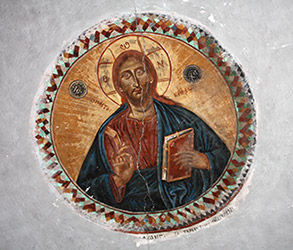
Doxaras is also the creator of the oil painting and his greater work is the ceiling decoration of the Church of Saint Spyridonas.
Among the sculptors there are P. Prosalentis, the first one with a neoclassic style in the modern Greece, and J. Kalosgouros among whose works there is the marble bust of Countess Helen Mocenigo.
Among the artists of the last century there are the sculptor D. Veyias, the first who practiced engraving art, the landscape architect C. Pachis who founded a painting school, the painter A. Giallinas specialized in water colour, the portrait painter G. Samartzis who has a style that remembers the French
post-impressionism and the sculptor-painter M. Zavitsianos who excels for his lithograph.
Architecture
The first examples of architecture went back to Corinthians; in Kanoni peninsula still today there are the rests of the circular grave of Menecrate and parts of many Doric temples.Decorative elements present in these buildings, like the frieze of Medusa and the lion carved in stone, are preserved today in the Archaeological Museum.
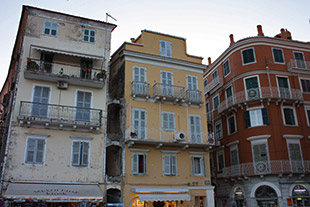 During the Byzantine domination numerous churches were built in Byzantine style with a central dome supported by four arches, small domes in the four angles and three apses towards east.
During the Byzantine domination numerous churches were built in Byzantine style with a central dome supported by four arches, small domes in the four angles and three apses towards east. Very few survived the various earthquakes that shook the island.
Today on the island there are different kind of ancient/old constructions.
In the countryside the majority of the old houses are very simple: they are stone houses on one or two levels with a wooden sloping roof.
Afterward these typical houses in Byzantine style were characterized by external stairs instead of inner ones and verandas bigger and bigger where to pass the warmer hours of the day.
After the annexation of Ionian Islands to Greece the economic situation of Corfu improved bringing an improvement also to the architecture.
The houses began to be adorned with neoclassical elements and arches lending a more refined look to the buildings.
Instead the old town of Corfu has a different story.
The first city of Corfu was built in XIII century and today does not exist anymore, a part few rests in the Paleopolis; the present old city date back to Venetian and English period.
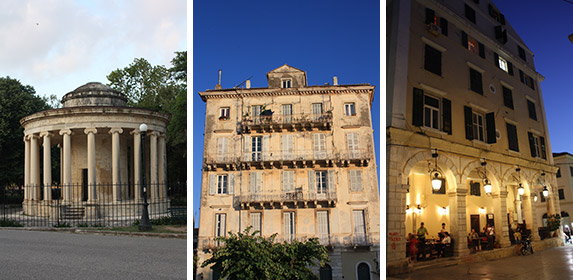
These buildings feel the effect of wars, sieges and poverty that mark the years they had to cross in order to arrive till now.
The Venetian buildings were built in small plots of land, so to utilize better the space they were made on many floors with simple forms and unadorned facades, without courtyards and without hygienic services and corridors inside.
Still today it's easy to recognize the Venetian buildings from the windows arranged symmetrically, the main entrances, the arches, the stone balconies and the shutters with the green frames and the white decorations.
The buildings of the nobles have a polished architectonic style and they are recognizable for the carved main entrances, the big cornices and other decorations.
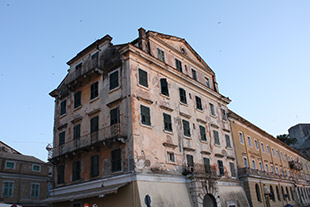
In comparison with the Venetian houses the English palaces are higher and planned and constructed with more attention to details; there is also the introduction of the bathroom.
In the city besides the buildings there are numerous churches, the majority of which was constructed between 1550 and 1750.
Generally they are basilicas with one nave, rarely with three naves, with a wooden roof, the altar, the main area and the women's gallery.
The bell towers and the ceilings of the nave, decorated with golden frames with inside religious depictions, are very particular.
Among the several architects who worked in Corfu one of the most illustrious is J. Chronis who planned the house of Capodistria, the Ionian Parliament, the Ionic Bank, many private buildings in the city and in the countryside, the church of Saint Sofia and the Church of Mandrakina.
Music
Music is a great passion for Corfiots, also during the Venetian domination there were musical shows in the public squares.The music played and sung in Corfu is a combination of Greek and Byzantine elements with the influences of Venetians and English.
Serenades, popular songs, religious hymns, folk songs and grand operas coexist at the same time.
Venetians brought to Corfu the Opera and in 1733 they inaugurated the first theatre, called Saint James like the adjacent church, with a musical performance.
During the English protectorate the first school of music was opened by N. Mantzaros; he was famous because had composed the melody for the poetry of D. Solomos that later became the Greek national hymn.
Mantzaros composed numerous symphonies
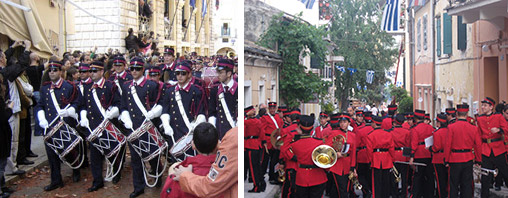 but his first passion was the teaching; he had many students among which S. Xyndas, the composer of the first Greek Opera.
but his first passion was the teaching; he had many students among which S. Xyndas, the composer of the first Greek Opera. In Corfu there were other important composers like Samaras, one of the founders of the Italian School of Opera and composer of the hymn of Olympic Games disputed in Athens in 1896, and later Kaisaris brothers who were the first to create a military band in Greece.
The first musical institution founded in Corfu in 1840 was the "Philharmonic Society of Corfu" that debuted the following year during the procession of St. Spyridonas.
The main reason that brought to the creation of the first Philharmonic Society was the refusal of the English to play during the orthodox processions.
Fifty years later the "Philharmonic Society Mantzaros" was founded and in 1980 also the "Philharmonic Union of Capodistrias". Currently there are 18 in all the island.
Today in Corfu, besides the famous Philharmonic Societies, there are various choirs among which the municipal one, the Corfiot Serenade and the Choir of Corfu formed by 50 elements that performed in all Greece and abroad.
These choirs have a repertory that comprises serenades, classic songs, opera, musical, modern and ancient popular songs.
On the island there are also two schools of music, one in the main town and the other in Lefkimmi.
The conservatory of Corfu is second for importance only to Athens one and it includes different schools for singing, composition, wind instruments, string instruments, ecclesiastical Byzantine music and musical informatics.
The musical culture in Corfu is very lively and this is confirmed by the presence of all the musical institutions on the island.
Musical tradition is maintained but there is also an openness to modern music and modern instruments.
Theatre
The first theatre of Corfu was opened by Venetians in 1720.The building that today is the town hall by that time was the Loggia of the Nobles that was transformed in the lyric theatre "Saint James" (called like the catholic church present in the public square in which it is situated).
The theatre was so loved by the Corfiots that remained opened and active also in 1798 under the siege of Russian-Turk fleet.
In 1903 the "Saint James" theatre became the Municipality of Corfu and a larger theatre was constructed but it was destroyed during the second world war.
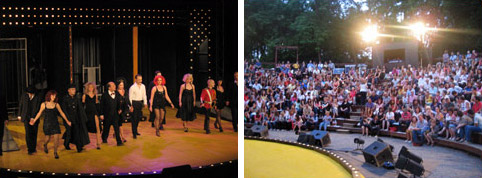
Today the theatrical performances take place in the municipal theatre and in the two fortresses of the city and there are a lot of theatre associations on the island.
Among the most important there are the Corfiot Ballet (folkloristic ballets or ballets based on myths and local legends), the Corfiot Stage (produced numerous dramas and the first tragedy performed by a not professional company in Corfu) and the Feaci Theatre Laboratory (this is a young group that experiment with particular and fanciful works).
